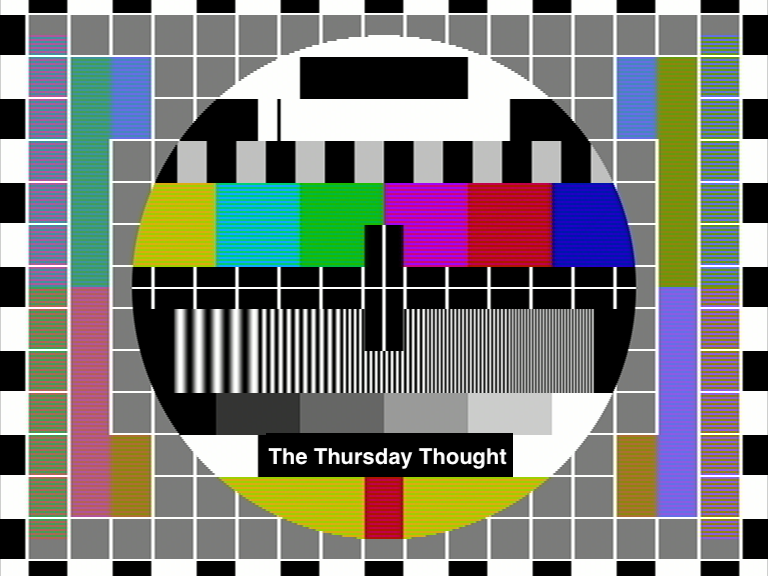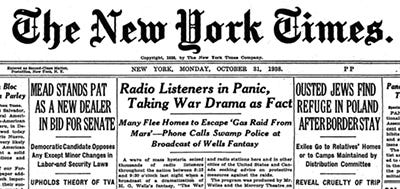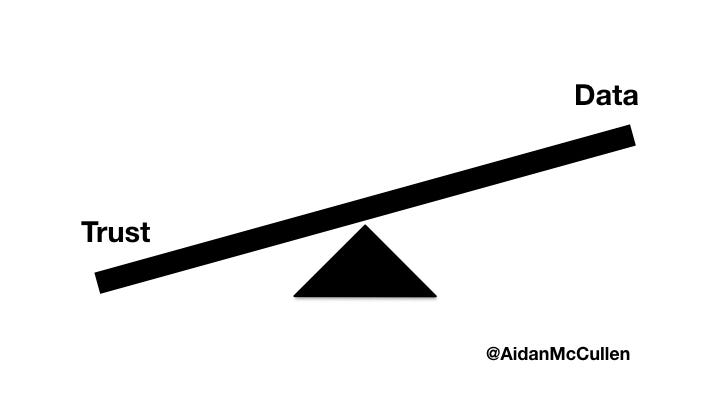
“Those who can make you believe absurdities, can make you commit atrocities.” — Voltaire

In 1938, CBS radio broadcast an episode of a drama called “The War of the Worlds”, directed and narrated by the actor (and future filmmaker) Orson Welles. The episode caused panic among its listening audience, who believed the alien invasion that Welle’s spoke of was actually happening. “Some listeners heard only a portion of the broadcast and, in the tension and anxiety prior to World War II, mistook it for a genuine news broadcast. Thousands of those people rushed to share the false reports with others or called CBS, newspapers, or the police to ask if the broadcast was real. Many newspapers assumed that a large number of phone calls and the scattered reports of listeners rushing about or even fleeing their homes proved the existence of mass panic, but such behaviour was never widespread.”
It’s worth noting that “The War of the Worlds” panic was an invention — it was itself a fake. The newspaper industry sensationalised the panic to prove to advertisers, and regulators, that radio management was irresponsible and not to be trusted. Vested interests want to undermine news. So any repositioned public broadcaster will have to deal with that, and think hard about a strategy to either become less vulnerable to attack (more trustworthy).
In 1938, mass media was much easier to control, the distribution of information was limited, there were newspapers, there was TV and there was Radio. Imagine how quick such panic would spread today? The bigger question is how would we know what to believe?

Today our challenge is not access to information, but rather an abundance of information. Whenever there is a new abundance, such as information and data, there are new scarcities. One of the scarcities of the information age is attention, the other is a scarcity of trust.
“The Defenders”
“The media’s the most powerful entity on Earth. They have the power to make the innocent guilty and to make the guilty innocent, and that’s power. Because they can control the minds of the masses.” — Malcolm X

While the ‘War of the Worlds’ episode is a relatively well-known event, here is a lesser known science fiction story, but one that is very relevant today. The story is called “The Defenders”. It was written by the brilliant Philip K. Dick (1928–1982), who brought us the concept of pre-crime (Minority Report) and we are seeing the first steps towards this concept in China. Dick also brought us ‘Blade Runner’ and ‘Total Recall’ to name but a few others.
“The Defenders” (1958) explores an alternative history where the Cold War had become a nuclear war. US and Soviet citizens were forced to move to underground bunkers.
Radioactivity-immune robots (artificial intelligence) known as “leadys” (made of lead, resistant to radioactivity) continue to wage war on Earth’s devastated surface that is too dangerous for humans. When something unusual is detected during one of the periodic robot interviews, a team of humans (equipped with protective suits) venture close to the surface and discover that the war is a hoax. The robots had attempted to delay the humans as long as possible, but the group discovers the surface is perfect and adorned with abundant forests, living animals, and even a farm. The leadys reveal that the war ended as soon as the humans evacuated because the robots could not see a rational purpose for it. Analyzing history, they found that groups of humans warred with each other until they matured to overcome conflict. Humanity is almost ready for a single culture, the current worldwide division into American and Soviet sides being the final step. The leadys created counterfeit photographs of the devastated planet to fool humans while destroying weapons they received and rebuilding the world for their creators’ return.
I share this story because what struck me is that humanity lives underground for eight years believing war is raging on the surface of the planet. Mankind is spoon fed enough information to believe this false reality and lead a very different existence. This suggests the power of the control of information. Information feeds our minds and our minds create our worldviews and our worldviews influence our realities.
The Offenders
“Whoever becomes the leader in artificial intelligence will become the ruler of the world.”- Vladimir Putin in 2017
Generative Adversarial Networks (GAN) are a relatively new concept in Machine Learning, introduced for the first time in 2014. Their goal is to synthesise artificial samples, such as images, that are indistinguishable from authentic images. American technology company Nvidia released a paper recently and a site that shows how AI can create images of people who do not exist. Have a look for yourself https://thispersondoesnotexist.com.
“Meh!”, I hear you think. But, what if you could go beyond creating images of people who do not exist?
What if you could create fake videos of real people speaking?
What if artificial intelligence could do this without any human direction?
What if you could create videos of world leaders addressing the public?
What if artificial intelligence could: script the video, create the video and distribute it?
Deepfakes is a portmanteau of “deep learning” and “fake”. Deepfakes are videos that use artificial intelligence to produce sophisticated doctored videos. Until recently, deepfakes were limited to the face and mouth, but now they are possible with whole bodies.
So why does this matter?
If you are so inclined you can create a video of someone appearing to do something that they never actually did. Equally, you can have them appear to say something they never actually said. If you think this would be hard to do, it will become increasingly easier, as easy as putting a snapchat filter on your own face. Movie studios have been able to map faces onto other actors for years, for example, if an actor tragically passed away during a movie as was the case with Oliver Reed in the movie “Gladiator”. Deepfakes have been created to insert the faces of celebrities in pornography, which has caused emotional trauma to friends and families and the celebrities themselves.
On a macro scale, this technology could be extremely dangerous. Let’s think back to the panic caused in 1938 by Orson Welles’ radio broadcast and the impact of the control of information by artificial intelligence in the 1958 sci-fi novelette “The Defenders” — influencing the message and its distribution is a powerful advantage.
I highly recommend the 1997 movie “Wag The Dog”. It tells the tale about how a spin-doctor (Robert DeNiro) and a Hollywood movie producer (Dustin Hoffman) join forces to fabricate a war in order to cover up a Presidential sex scandal. While this is a movie, there have been many comparisons made over the years since the release. With the power of the internet, algorithmic distribution lying with major platforms like Google and Facebook, favouring certain news stories overs is a powerful tool. While the power has shifted from traditional media sources like TV, Radio and Press, it now lies with whoever controls the algorithm.
Moore’s Law and Momo’s Challenge
As technology becomes increasingly powerful and Moore’s Law and Quantum computing continue to progress at an exponential rate, it will become increasingly easy to create deepfakes. The Momo suicide challenge is on the public agenda, but I know of no-one who has seen the video. What I do know it that it caused Global moral panic throughout society. People are panicking over something they have not actually witnessed. Society has poured fuel on the Momo story and it has spread fear throughout society. The virility of the story goes beyond the internet, it is spread by word of mouth.
Here is a question to ponder. What if instead of Momo, (which to most people is a passed-on story and a distorted image of a woman with turkey feet — as far as I can make out) it was an AI-created deepfake of the president of a global power committing an undesirable act, or giving some national call to action?
If that happened where would we turn to discover the truth? Who could we trust?
Is this not where the true value of a public broadcaster is? Trust?
The Value of Public Broadcasters
On this week’s innovation show, we talk with David McRaney, the author of “You are not so smart”. On the show, we discuss some of the multitudes of biases, heuristics (mental shortcuts) and fallacies we experience every single day. One of these is the availability heuristic. Heuristics can be mental shortcuts that ease the cognitive load of making a decision. The availability heuristic is our tendency to accept the information that is most recently and easily available as true. When you combine the availability heuristic with the mere exposure effect (where we develop a preference for things merely because they are familiar with them) you can see why Internet memes can be so powerful.
Digital publishers and Blogs often rely on iterative journalism: publish first, fact-check and revise later. In the first stage of iterative journalism, a blog often publishes an article based on even the bones of a story with minimal fact-checking. Digital journalists are often interested more in breaking the story, than breaking the true story. When digital journalists are incentivised and measured on the traffic to their stories this influences their behaviour, which is natural and expected.
Fact checking is becoming increasingly difficult and time-consuming as we have touched on earlier. If a publisher does not break a story quickly, the public often criticises them, in fact, the company will often criticise its own journalists for being slow on the draw — especially if it has a commercial remit! If an article is reported to be or discovered to be faulty, the journalist can change the headline or alter the facts as they are discovered, but oftentimes, by then the misinformation is in the system.
So as traditional media continues to decline, who will be the trusted media to inform the public what their public institutions are doing? Who will cover the stories that do not show a return on investment? Who will provide cultural content that is not economically viable? Who will cover community events that cost a significant amount to produce?
I believe this is the value of a public broadcaster. I believe this is why a public broadcaster should not have a commercial remit because having commercial liability changes incentives and motivations, where you may be inclined to favour clicks over facts. In Ireland, the public broadcaster recently invested in an updated digital player and they did a great job. However, it does not address the pain point for the public — the experience is ruined by pre-roll advertising and in-stream advertising. The reality is we compare any player to Netflix, that is where the bar is set for the public. A possible solution? Remagine the TV license fee as a national and cultural subscription fee. The subscription is an investment in indigenous content and an agnostic, commercially unsullied subscription service at that.
I believe a public broadcaster should be funded through our taxes, but first, the swamp of many public broadcasting bodies must be drained. The public may subscribe to great content, but they do not want to subscribe to inefficient organisations.
Draining the Swamp and Trusting the Well

“Success is dangerous. One begins to copy oneself, and to copy oneself is more dangerous than to copy others. It leads to sterility.” — Pablo Picasso
In the past, the narrow funnel of media distribution meant huge power for those with mass distribution. It meant more than controlling information, it meant advertisers had no choice but to spend with your media outlet. Like many organisations who were privileged with a competitive barrier like distribution, it nurtured complacency. We saw this with the taxi industry and medallions, we saw this with retailers and customer experience, we saw this with newspapers and distribution. All of that was pre-mass digitisation. Pre Uber, pre-Amazon and pre-digital media.
A huge bugbear for the public is that many public sector workers in well-paid, privileged roles are riddled not only with complacency but with arrogance and a poor work ethic. Why? Because the speed of change in such organisations is glacial because commercial pressures have been always a government bailout away. Meetings upon meetings to ensure groupthink paralyse such organisations from making critical decisions. I hasten to add, there are some great people in these organisations. There are people who truly believe in their role as public servants. There are people with excellent work ethics. However, these good eggs are often ostracised and held back by the bad eggs.
Thankfully, we are seeing decisive decisions here in Ireland by the state broadcaster, which has culled a large amount of hubris and complacency at a significant financial cost. While there are always good people who leave when redundancy is offered, there are also many weaker staff who opt to stay. When they stay, they can become cancerous to the organisation and impact negatively those who embrace progress.
Reinventing and re-energising an established, public organisation takes time. Until this is complete, those who you want to move on often mask the good work of those who you want to keep.
When there is Poison in the Well, You Can’t Trust the Water

This article covers two types of well. The first is the well of the people in a public organisation. There are great people in these organisations, but when there is some poison in the well of that organisation, it can spoil the water for everyone. Cleaning the well takes time and perseverance.
The second well is the well of information. With the rise of fake news and deepfakes powered by rapid internet distribution, we need a well of information that we can trust.
The second well is the well of information. With the rise of fake news and deepfakes powered by rapid internet distribution, it means there is poison in the well and even if there is some poison in the well, you cannot trust the water. Every nation needs a trusted source. This source must be impartial, unbiased, without agenda. It should be pure information as much as is possible. To ensure this, the organisation providing the information must be publicly funded. Voltaire once wrote: “To find out who rules over you, simply find out who you are not allowed to criticize.”
“When copies are free, you need to sell things that cannot be copied. Well, what can’t be copied? Trust, for instance.” ― Kevin Kelly
Thanks for Reading
This week’s innovation show examines the assorted ways we mislead ourselves every single day, a psychology course with all the boring bits taken out. Prepare for a whirlwind tour of some of the latest research, fused with a healthy dose of humour. You’ll discover just how irrational you really are, which delusions keep you sane, how to boost your productivity, and why you’ve never kept a New Year’s resolution.
Our guest is the author of “You Are Not So Smart: Why Your Memory Is Mostly Fiction, Why You Have Too Many Friends On Facebook And 46 Other Ways You’re Deluding Yourself” and host of the You Are Not So Smart Podcast, David McRaney
We discuss:
- What are Biases, Heuristics and Fallacies
- Why we create mental shortcuts
- The ancient architecture of the brain
- Priming
- How Casinos Prime Us
- Confabulation
- Split-Brain patients and confabulation
- Why our brains seek patterns
- The Texas Sharpshooter Fallacy
- The Availability Heuristic
Have a listen:
Soundcloud https://lnkd.in/gBbTTuF
Spotify http://spoti.fi/2rXnAF4
iTunes https://apple.co/2gFvFbO
The Texas Sharpshooter Fallacy video mentioned during the show:
More about David here: